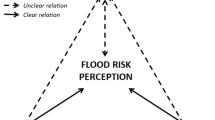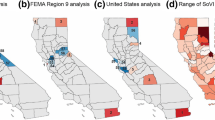Abstract
A wide range of scales and indices are used to describe natural hazards and theirimpacts. Some scales infer damage levels from hazard characteristics while othersuse damage levels to estimate a physical characteristic. Damage scales may relyon raw dollar values, percent loss estimates, damage states, normalized values ormacrodamage categories. Whatever the basis of the scale it should tell the truth.However, scales are compromises between the need for detailed information andbeing simple enough to use.
Damage scales may be nominal (categorical), ordinal, interval or ratio scales. Frequencywords such as ``few'', ``many'' can be dealt with in a range of ways to produce contiguous,widely separated, broadly overlapping or narrow overlapping values. Most scales rely onmaximum values but some focus on minimum or threshold values. The number of levelson damage scales commonly ranges from five to 13. Some long-lived damage scales haveevolved through several editions, changing to reflect the new or additional uses to whichthey have been put and as buildings and the nature of damage to those structures has changed.
Few scales state precisely the purpose of the scale, deal clearly with ambiguities or provideguidelines for the use of qualitative information.
Similar content being viewed by others
References
Alexander, D.: 1980, The Florence floods: what the papers said, Environmental Management 4(1), 27–34.
Alexander, D.: 1989, Urban landslides, Progress in Physical Geography 13, 157–191.
Black, M.: 1963, Reasoning with loose concepts, Dialogue 2, 1–12.
Blong, R. J.: 1988, Assessment of eruption consequences, Proceedings Kagoshima International Conference on Volcanoes, pp. 569–572.
Bolt, B. A.: 1978, Earthquakes-A Primer, Freeman, San Francisco, 241 pp.
BRED: 1981, Assessment of damage in low-rise buildings with particular reference to progressive foundation movement, UK Building Research Establishment Digest 251, 8 pp.
Capen, E. C.: 1976/1985, The difficulty of assessing uncertainty, in Evaluating and Managing Risk – A Collection of Readings, SciData Publishing, pp. 7–14.
Casadevall, T. and Budding, K.: in prep., Volcanic ash and aviation safety: Database for encounters between aircraft and ash clouds, U.S. Geological Survey Bulletin.
Charlton, R. B., Kachman B. M., and Wojtiw, L.: 1995, Urban hailstorms: a view from Alberta, Natural Hazards 12(1), 29–75.
Coburn, A. and Spence, R.: 1992, Earthquake Protection, John Wiley & Sons, Chichester, U.K.
Cochrane, S. W. and Schaad, W. H.: 1992, Assessment of earthquake vulnerability of buildings, Earthquake Engineering, 10th World Conference, Balkema, Rotterdam, pp. 497–502.
Crowder, B.: 1995, The Wonders of the Weather, Bureau of Meteorology, Australian Government Publishing Service, Canberra, 270 pp.
Davidson, R. A.: 1997, An Urban Earthquake Disaster Risk Index, John A. Blume Earthquake Engineering Center, Stanford University, Report No. 121, 269 pp.
Dowrick, D. J.: 1996, The Modified Mercalli Intensity Scale – Revisions arising from recent studies of New Zealand Earthquakes, Bulletin of the New Zealand National Society for Earthquake Engineering 29(2), 92–106.
Eiby, G. A.: 1989, Earthquakes, Heinemann Reed, Auckland, 166 pp.
Faigin, B. M.: 1976, 1975 Societal Costs of Motor Vehicle Accidents, US Department of Transportation, National Highway Traffic Safety Administration, Washington, 35 pp.
FEMA: 1985, An Assessment of Damages and Casualties for Six Cities in the Central United States Resulting from Earthquakes in the New Madrid Seismic Zone, prepared for US Federal Emergency Management Agency, Central United States Earthquake Preparedness Project, Contract EMK-C-0057.
Foster, H. D.: 1976, Assessing disaster magnitude: a social science approach, Professional Geographer 28(3), 241–247.
Fujita, T.: 1981, Tornadoes and downbursts in the context of generalized planetary scales, Journal of the Atmospheric Sciences 38(8), 1511–1534.
Granot, H.: 1995, Proposed scaling of the communal consequences of disaster, Disaster Prevention and Management 4(3), 5–13.
Grünthal, G. (ed.): 1993, European Macroseismic Scale 1992 (up-dated MSK-scale), European Seismological Commission, Conseil de l'Europe, Cahiers du Centre Européen de Géodynamique et de Séismologie, Luxembourg, volume 7, 79 pp.
new/INDEX.HTML
Hakel, M. D.: 1968, How often is often?, American Psychologist 23, 533–534.
Hamblin, A.: 1998, Environmental indicators for national state of the environment reporting – the land, Australia: State of the Environment, Environmental Indicator Reports, Department of the Environment, Canberra.
Handmer, J.: 1989, The flood risk in Australia, in J. Oliver and N. R. Britton (eds.), Natural Hazards and Reinsurance, Proceedings of a seminar sponsored by Sterling Offices (Australia) Ltd., Cumberland College of Health Sciences, Sydney, pp. 45–59.
Hatori, T.: 1964, A study of the damage to houses due to a tsunami, Bulletin of the Earthquake Research Institute, University of Tokyo 42, 181–191.
Hirschberg, J. H., Gordon. P., and Petak, W. J.: 1978, Natural Hazards: Socio-Economic Impact Assessment Model, NSF/PRA-7509998/5, J. H. Wiggins & Co, Redondo Beach, California.
Holmes, T. H. and Rahe, R. H.: 1967, The social readjustment rating scale, Journal of Psychosomatic Research 11, 241–247.
Iida, K.: 1963, Magnitude, energy and generation mechanisms of tsunamis and a catalogue of earthquakes associated with tsunamis, International Union of Geodesy and Geophysics Monograph 24, 7–17.
Inhaber, H.: 1976, Environmental Indices, Wiley, New York, 178 pp.
Kaly, U., Briguglio, L., McLeod, H., Schmall, S., Pratt, C., and Pal, R.: 1999, Environmental Vulnerability Index (EVI) to summarise national environmental vulnerability profiles, South Pacific Applied Geoscience Commission (SOPAC) Technical Report 275, Suva, Fiji, 67 pp.
Kanamori, H.: 1980, The size of earthquakes, Earthquake Information Bulletin 12(1), 10–15.
Keller, A. Z. and Al-Madhari, A. F.: 1996, Risk management and disasters, Disaster Prevention and Management 5(5), 11–18.
Klyachko, M. A.: 1996, The scale for Disaster Magnitude Measurement – The DIMAK Scale for Disaster Magnitude Measuring, Ministry of Construction, Russia, unpub.
Krinitizsky, E. L.: 1993a, Earthquake probability in engineering – Part 1: the use and misuse of expert opinion, Engineering Geology 33, 257–288.
Krinitizsky, E. L., 1993b, Earthquake probability in engineering – Part 2: Earthquake recurrence and limitations of Gutenberg – Richter b-values for the engineering of critical structures, Engineering Geology 36, 1–52.
Lehmann, D. R. Gupta, S., and Steckel, J. H.: 1998, Marketing Research, Addison-Wesley, Massachusetts.
Leicester, R. H. and Reardon, G. F.: 1976, A statistical analysis of the structural damage by Cyclone Tracy, Annual Conference Institution of Engineers, Australia, Townsville, pp. 242–247.
Marshall, T. P.: 1985, Damage analysis of the Mesquite, Texas tornado, 5th Conference on Wind Engineering, American Society of Civil Engineers, New York, Session 4B, pp. 11–18.
May, F. and Popish, T.: 1990, Northern Utah Earthquake Handbook – Risk Assessment and Loss Estimation, Utah Division of Comprehensive Emergency Management, 89 pp.
McCalpin, J. P. (ed.): 1996, Paleoseismology, International Geophysics Series, 62, Academic Press, San Diego, 520 pp.
McCann, M. W., Sauter, F., and Shah, H. C.: 1980, Technical note of PGA – intensity relationships with applications to damage estimation, Bulletin Seismological Society of America 70(2), 631–637.
Meaden, G. T.: 1976, Tornadoes in Britain; their intensities and distribution in space and time, Journal of Meteorology 1, 242–251.
Met Office: 1963, Meteorological Glossary, Her Majesty's Stationery Office, London, 4th edition,288 pp.
Molak, V. (ed.): 1997, Fundamentals of Risk Analysis and Risk Management, CRC Lewis Publishers, Florida, 472 pp.
Munich Re: 1998, World Map of Natural Hazards, Munich Re, Munich, 55 pp.
Musson, R.: 1998, A Short History of Intensity and Intensity Scales, http://www.grsg.nmh.ac.uk/ phoh/histint.htm
Newhall, C. G. and Self, S.: 1982, The volcanic explosivity index (VEI): an estimate of explosive magnitude for historical volcanism, Journal of Geophysical Research (Oceans and Atmosphere) 87, 1231–1238.
Pacella, C. A.: 1982, A natural hazards information system for risk management, 7th Annual workshop on Natural Hazards Research and Applications, Boulder, Colorado, July 18–21, 1982 (M&M Protection Consultants, 1983).
Petersen, R. E. (ed.): 1974, Symposium on Tornados – Assessment of Knowledge and Implications for Man, Proceedings, June 22–24, 1974, Texas Technical University.
Powell, G. H. and Allahabadi, R.: 1988, Seismic damage prediction by deterministic methods: concepts and procedures, Earthquake engineering and structural dynamics 16, 719–734.
Rejewski, D.: 1993, GIS and risk: a three culture problem, in M. F. Goodchild, B. O. Parks and L. T. Steyaert (eds.), Environmental modelling with GIS, OUP, New York, pp. 318–331.
Reitherman, R.: 1985, A review of earthquake damage estimation methods, Earthquake Spectra 1(4), 805–847.
Richter, C. F.: 1958, Elementary Seismology, Freeman, San Francisco, 653 pp.
Rojahn, C.: 1986, ATC methodology and data for rapid assessment of seismic vulnerability, in C. Scawthorn (ed), Techniques for Rapid Assessment of Seismic Vulnerability, Structures Congress '86, New Orleans, American Society of Civil Engineers, pp. 21–40.
Saffir, H. S. and Simpson, R. H.: 1974, The Hurricane Disaster-Potential Scale, Weatherwise 27(4), 169, 186.
Scawthorn, C.: 1986, Rapid assessment of seismic vulnerability, in C. Scawthorn (ed), Techniques for Rapid Assessment of Seismic Vulnerability, Structures Congress ';86, New Orleans, American Society of Civil Engineers, pp. 1–20.
Simkin, T. and Siebert, L,: 1994, Volcanoes of the World, A Regional Directory, Gazetteer, and Chronology of Volcanism During the Last 10,000 Years, (2nd ed.), Geoscience Press, Arizona, 349 pp.
Simpson, R. H. and Riehl, H.: 1981, The Hurricane and Its Impact, Louisiana State University Press, Baton Rouge, LA.
Simpson, R. H.: 1944, The specific meanings of certain terms indicating differing degrees of frequency, Quarterly Journal of Speech 30, 328–330.
Spence, R. J. S., Coburn, A. W., and Pomonis, A.: 1992, Correlation of ground motion with building damage: the definition of a new damage-based seismic intensity scale, Earthquake Engineering, 10th World Conference, Balkema, Rotterdam, pp. 551–556.
Streamland: 1988, Water Quality Indexes – clear and simple water management tools, Streamland, New Zealand National Water and Soil Conservation Authority, 65, 4 pp.
Thomas, P. I.: 1983, How to Estimate Building Losses and Construction Costs, Prentice-Hall, New Jersey, 471 pp.
Tversky, A. and Kahneman, D.: 1974, Judgement under uncertainty: heuristics and biases, Science 185, 1124–1131.
UNDRO: 1991, Managing Natural Disasters – Phenomena, Effects and Options – A Manual for Policy Makers and Planners, Office of the United Nations Disaster Relief Co-ordinator, Geneva, 164 pp.
Walker, G. R.: 1987, A simplified wind loading code for small buildings in tropical cyclone prone areas, 7th International Conference on Wind Engineering, Aachen, West Germany, July 1987, 9 pp.
Whitman, R. V., Reed, J. W., and Hong, S. T.: 1973, Earthquake damage probability matrices, Proceedings 5th World Conference on Earthquake Engineering, Rome, pp. 2531–2540
Wood, H. O, and Neumann, F, 1931, Modified Mercalli intensity scale of 1931, Bulletin of the Seismological Society of America 21(4), 277–283.
Author information
Authors and Affiliations
Rights and permissions
About this article
Cite this article
Blong, R. A Review of Damage Intensity Scales. Natural Hazards 29, 57–76 (2003). https://doi.org/10.1023/A:1022960414329
Issue Date:
DOI: https://doi.org/10.1023/A:1022960414329




